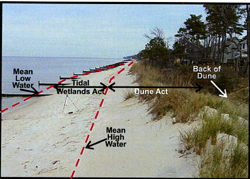Coastal Primary Sand Dunes and Beaches Act
The General Assembly enacted the Coastal Primary Sand Dune Protection Act (The Dune Act) in 1980, which covered nine Virginia Tidewater localities. The Dune Act was originally codified in Code § 62.1-13.21 to -13.28 and later recodified as Coastal Primary Sand Dunes and Beaches in Code § 28.2-1400 to -1420. In 2008, the Virginia General Assembly extended protection to all Tidewater dunes and beaches.
Primary dunes must meet three criteria to fall under the Act's jurisdiction:
 |
1. Substance: a mound of unconsolidated sandy soil contiguous to mean high water |
American beach grass (Ammophila breviligulata)

Beach heather (Hudsonia tomentosa)
Dune bean (Strophostyles spp.)
Dusty miller or OldWoman(Artemisia stelleriana
Saltmeadow cordgrass(Spartina patens)
Seabeach sandwort (Arenaria peploides)
Sea oats (Uniola paniculata)
American Searocket (Cakile edentula)
Seaside goldenrod (Solidago sempervirens)
|
1. Substance: zone comprised of unconsolidated sandy material upon which there is a mutual interaction of the forces of erosion, sediment transport and deposition that extent from the low water line landward. b.If no change is marked then the landward limit of the beach is defined by the nearest impermeable manmade structure, such as bulkhead, revetment, or paved road. |
 |

